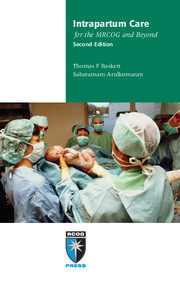Book contents
- Frontmatter
- Contents
- Preface
- Abbreviations
- 1 Improving intrapartum care
- 2 First stage of labour
- 3 Second stage of labour
- 4 Fetal surveillance in labour
- 5 Third stage of labour
- 6 Lower genital tract trauma
- 7 Induction of labour
- 8 Preterm labour and prelabour rupture of membranes
- 9 Assisted vaginal delivery
- 10 Shoulder dystocia
- 11 Breech vaginal delivery
- 12 Twin and triplet delivery
- 13 Caesarean section
- 14 Vaginal birth after caesarean section
- 15 Uterine rupture
- 16 Emergency obstetric hysterectomy
- 17 Cord prolapse
- 18 Antepartum haemorrhage
- 19 Postpartum haemorrhage
- 20 Acute uterine inversion
- 21 Amniotic fluid embolism
- 22 Disseminated intravascular coagulation
- 23 Acute tocolysis
- 24 Severe pre-eclampsia and eclampsia
- 25 Neonatal resuscitation
- 26 Perinatal loss: management of late fetal death and stillbirth
- Index
19 - Postpartum haemorrhage
Published online by Cambridge University Press: 05 July 2014
- Frontmatter
- Contents
- Preface
- Abbreviations
- 1 Improving intrapartum care
- 2 First stage of labour
- 3 Second stage of labour
- 4 Fetal surveillance in labour
- 5 Third stage of labour
- 6 Lower genital tract trauma
- 7 Induction of labour
- 8 Preterm labour and prelabour rupture of membranes
- 9 Assisted vaginal delivery
- 10 Shoulder dystocia
- 11 Breech vaginal delivery
- 12 Twin and triplet delivery
- 13 Caesarean section
- 14 Vaginal birth after caesarean section
- 15 Uterine rupture
- 16 Emergency obstetric hysterectomy
- 17 Cord prolapse
- 18 Antepartum haemorrhage
- 19 Postpartum haemorrhage
- 20 Acute uterine inversion
- 21 Amniotic fluid embolism
- 22 Disseminated intravascular coagulation
- 23 Acute tocolysis
- 24 Severe pre-eclampsia and eclampsia
- 25 Neonatal resuscitation
- 26 Perinatal loss: management of late fetal death and stillbirth
- Index
Summary
Worldwide, obstetric haemorrhage is the leading cause of maternal death, such that every 2–3 minutes a woman bleeds to death in childbirth. The vast majority of these deaths are in the developing world. While haemorrhage is not the main cause of maternal mortality in the developed world, it is the largest contributor to severe maternal morbidity. Furthermore, there are reports from Australia and Canada showing an increased prevalence of severe postpartum haemorrhage (PPH).
PPH is defined as bleeding from the genital tract in excess of 500ml within 24 hours of vaginal delivery and in excess of 1000ml within 24 hours of caesarean section. The reported incidence varies from 2% to 10% because blood loss is such a subjective appraisal. It is a clinical truism that doctors underestimate blood loss while patients overestimate it. This is supported by blood volume studies which show that the normal parturient loses about 500ml of blood at vaginal delivery and 1000ml at caesarean section. Thus, when the doctor estimates that a woman has lost 500ml at vaginal delivery, she has probably lost closer to 1 litre. Therefore, in terms of clinical management, the working definition of an estimated 500ml blood loss is a reasonable one. It is also advisable to have a lower tolerance for blood loss with small women who have a smaller blood volume and in those who are already anaemic. Because of the latter two factors, some define PPH as over 500ml estimated blood loss or that which causes haemodynamic changes.
- Type
- Chapter
- Information
- Intrapartum Care for the MRCOG and Beyond , pp. 211 - 224Publisher: Cambridge University PressPrint publication year: 2011



